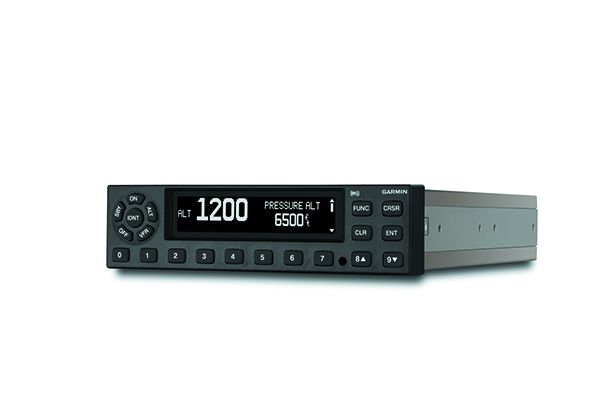Now that the much anticipated ADS-B mandate has come and gone, there’s still a need for replacement transponders. Yes, Mode C altitude reporting capability lives on. Some buyers opted for standalone ADS-B systems (the uAvionix tailBeacon and skyBeacon and Garmin GDL 88 units come to mind), which left plenty of aircraft still sporting basic Mode A/C squawk boxes
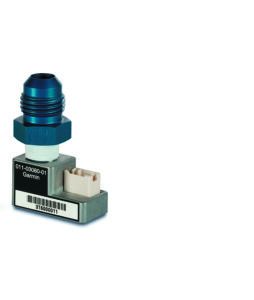
While we think ADS-B transponders make sense for a wide variety of aircraft, face it, some aircraft just don’t need ADS-B. This includes basic ones that operate in the backwoods, on the water or outside of mandate airspace. These are candidates for plain-vanilla Mode C systems.
For this select buyer, it’s a stark market for these basic altitude-reporting units, and we took a fresh look.
WHAT ABOUT ADS-B RIGS?
Our sense is the market for traditional non-ADS-B transponders is stark because manufacturers assumed early on that the majority of buyers would opt for a Mode S ADS-B model, and for the most part that turned out to be true.
Some companies, including Becker Avionics as one example, made a compact line of Mode C models that worked in a variety of applications, but it dropped the line because it just didn’t see the demand.
That begs the question of whether you should you buy an ADS-B Out equipped transponder even if you don’t use it for ADS-B, which means not connecting it to a WAAS GPS position source. If you already have ADS-B Out via a 978 UAT system, we don’t see the need to spend the extra money for one unless you’re still concerned about the Canadian ADS-B requirement for 1090ES/Diversity transponder-based systems, which for the time being has been put on hold.
But if you’ve acquired an aircraft that still needs an ADS-B upgrade (or are finally getting around to equipping your existing one—that’s still the case for some), we think it almost always makes sense to go for one that does ADS-B and Mode C. It could be the last transponder you ever install.
Still, Garmin thinks there is still a need for basic Mode C squawk boxes, so it created a follow-on product to an already popular unit. Read on.
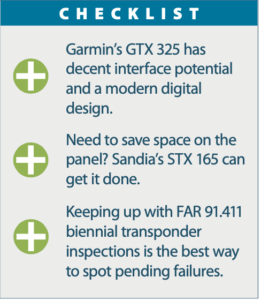
GARMIN GTX 325
Garmin’s all-digital GTX 327 Mode A/C transponder was a huge seller and was often paired with GNS 430/530 navigators. While the GTX 327 has been discontinued and replaced by the GTX 325, you might find a used GTX 327 worth buying, but only if the price is right. More on that in a minute.
Priced at $2295, Garmin told us that it targets the GTX 325 to buyers who already have an ADS-B Out solution and to those who don’t fly in ADS-B mandate airspace. Makes sense.
The GTX 325 is sized 1.68 by 6.30 by 10.07 inches and that makes it easy to replace an existing analog transponder without having to reconfigure the radio stack, although we wish it had a more shallow chassis for saving space behind the panel. For panels where the transponder is displaced away from the fingertips, the unit has a digital databus for onscreen code and Ident selection on Garmin’s current GTN-series navigators.
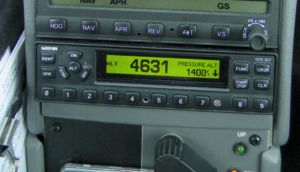
One feature we like about the GTX 325 that trickles down from Garmin’s flagship models is how the unit accommodates Garmin’s $249 GAE 12 pressure altitude sensor. Think of it as a smart encoder. The GAE 12 is literally the size of a quarter and its static fitting is actually larger than the chassis it sits on.
The GAE 12 screws to the back of the transponder tray and the static line connects directly to it. The advantage is that if the transponder has to be removed for repair or replacement, the GAE 12 encoder stays put and the static system remains undisturbed. That avoids the hassle and expense of recertifying the static system. It saves time and money.
From a feature set standpoint, the GTX 325 brings many of the smart functions that are familiar on other units in Garmin’s lineup, including a sunlight readable LCD display. It also has useful features including a pressure altitude readout so you always know what the altitude encoder is outputting. When interfaced with an optional temperature sensor, the unit will display density altitude and of course static air temperature.
Carried over from the GTX 327 is a full-featured timer including count up, count down, trip time and flight time. There’s also an altitude monitor with aural alerting (for tying into the audio panel) that displays the current deviation from a selected altitude. Wander off the altitude (which has presettable limits) and you’ll get an attention-getting “leaving altitude” warning.
Aside from basic push-button code entry there’s an automatic VFR button, while the unit holds the previous squawk code in memory. Contact www.garmin.com.
SANDIA AEROSPACE
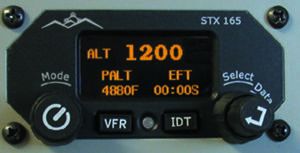
New Mexico-based Sandia has a variety of products, such as cooling fans, altitude encoders and EFIS, and for a couple of years it has been selling the $1950 STX 165 transponder.
It’s a space-saver (and weighs 1.3 pounds) with a 3 ATI bezel, and has an OLED display that does we’ll in sun-splashed cabins. The display is small, and it displays a lot of data including pressure altitude and a three-function timer, and has an option for OAT probe input for additional displayed data.
As transponders go, the STX 165 is somewhat untraditional in form factor, but with a simple user control set that’s worth a run-through for those only accustomed to using the more common design. There’s a mode control knob, a VFR key, an Ident push-button and a data knob with a push-button for use as an Enter key. This is a dual concentric knob with push-button action. There’s also a photocell for automatic display dimming, plus you can set the minimum and maximum levels for which it will adjust.
The Power button has two additional functions. One is as an Escape mode. If the operator is in a programing mode and wishes to escape to the main page, he can press the Power button momentarily. This will cancel all programming and show the normal display page. This is smart given the need for no-nonsense on-the-fly transponder functions, like changing the code immediately.
The other use for the Power button is controlling the transponder’s three timer functions. These include elapsed flight time, count up and count down. To select a timer rotate the Data knob either clockwise or counterclockwise.
The other knob on the lower right of the bezel (Data knob) is used for data entry. The larger Select knob is a momentary switch that is spring loaded. It can be turned clockwise and counterclockwise and will return to center when released. It is used to move the cursor during code selection and to toggle through the display options in the lower left display (PALT for pressure altitude, DALT for density altitude and OAT for static air temperature). The transponder will display temperature in either degrees Fahrenheit or degrees Celsius.
And like the Garmin GTX 325’s optional probe, it’s worth mentioning that these functions are only available if the optional Sandia STP 78 OAT probe ($350) is installed. For many we think the accessory may be worth the effort to install. Best of all, the STP 78 OAT probe will provide an attention-getting icing alert on the transponder. The icing alert is a snowflake that appears in the upper right corner of the display whenever a user preset temperature is reached. The snowflake symbol will blink for 10 seconds once the icing alert temperature is reached, then remain solid until the temperature goes above the preset temperature. Smart and useful.
The smaller inner knob is the Data knob and is used to select the digit value when programing the squawk code and to select the counter function in the lower right display (when not in the code selection mode).
As for the display, the upperleft portion of the screen will show the current transmitter mode. The upper right portion of the display will show the last squawk code that was selected prior to shutdown; the pressure altitude is displayed in the lower left and elapsed flight time in the lower right of the display.
Perhaps what we like the most is the integral 35,000-foot TSO-certified altitude encoder. It has a feature where the user can set the transponder to come on in the altitude reporting mode at startup or at a predetermined altitude differential after takeoff. The system also outputs pressure altitude data on an RS232 databus.
Last, there’s a remote version of the transponder, the STX 165R. It’s priced at $1800, geared toward experimental applications and doesn’t have a built-in altitude encoder. It displays on Dynon, Advanced Flight and GRT experimental displays. Contact www.sandia.aero.
ENCODERS AND ANTENNAS
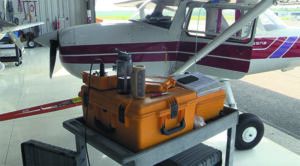
What might you budget, all in, for a Mode C transponder upgrade? There are lots of variables. These are two accessories that drive up the costs of basic upgrades. You’ll need to rely on the advice of your installer on whether the existing antenna will survive the long haul. Installed on the bottom of the aircraft, L-band transponder antennas live tough lives and are often neglected.
You’ll see two styles: a short metal rod/ball or a fiberglass fin. The fin is more durable, generally offers better performance and of course is more expensive.
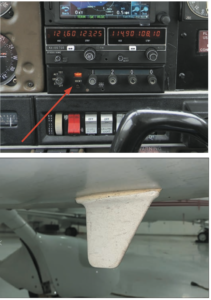
Don’t forget the antenna cable. The shop may want to replace it if it’s older RG58. That’s a good plan, in our view. There’s no sense in installing a new transponder and encoder only to have signal issues with antenna cable that could be as old as the airplane.
The other accessory to be concerned with is the altitude digitizer, otherwise known as the blind encoder. In addition to getting more compact over the years, they have also become more advanced to accomodate the needs of other avionics in the stack that require pressure altitude—everything from autopilots to GPS navigators.
The industry has pretty much transitioned to serial data pressure altitude interfaces through an RS 232 link, as opposed to old-school Gray code. Serial data can be software coded to suit the input requirements of any avionics and it requires just a twisted pair of wires. This can reduce installation complexity, but still adds to the cost of even a basic transponder project. How much? It depends on the model and the level of interface.
One popular model comes from Transcal—an industry veteran based in California. The most popular option is probably the SSD120-30N, which retails for about $350. The “30N” designation means it has a 30,000-foot operating ceiling.
As mentioned, Garmin’s GAE 12 digitizer is perhaps the smartest design we’ve seen, and perhaps one of the easiest encoders to install. It’s technician-friendly—no accessing sidewalls or climbing in tight spots to work with it.
But the Sandia transponder has a built-in encoder, which means there’s no encoder to buy or install.
We’ll look at encoders in a separate article upcoming in Aviation Consumer.
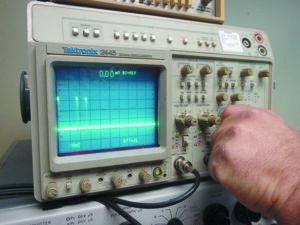
Feel the heat that most high-powered mechanical transponders generate in the main radio stack and it’s no surprise that old cavity-driven models are on their last leg. So when searching the used market for a sweet deal on a transponder, choose wisely. As we mentioned in the main article, one good choice is the Garmin GTX 327.
This is an all-digital Mode A/C model that was a popular pairing with the Garmin GNS navigators and has a good service record because of its solid-state design and rugged control set. Plenty still exist, but many are being removed for a relatively easy transition to Garmin’s flagship ADS-B Out GTX 345.
Doing a fresh search on the used avionics market, we found GTX 327 units priced as low as $500 and as high as $1200 after a factory repair. In our view $650 to $700 might be more in line if it includes mounting rack and connectors. Don’t forget the antenna and altitude encoder, though, which probably won’t be included in the sale.
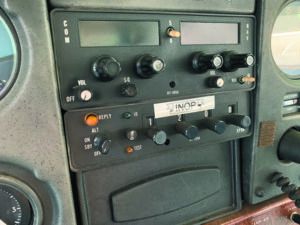
Like any used-market buy it takes a good eye to pick a cherry and it should be obvious which ones lived a hard life. Are the labels on the function keys worn? Is the display and lens healthy? Team with an avionics shop that can put the unit on the test bench to make sure it’s a keeper. The right unit could be the best solution, but keep in mind that it may not be the best solution if you need ADS-B Out and a transponder. Garmin charges a flat-rate repair fee of $590 for any unit that comes back to the factory, and it’ll be slapped with a one-year warranty after the repair.
But don’t throw good money after bad. We caution against spending anything on an analog transponder. That is, one with a mechanical switch deck and cavity oscillator. Legacy models from King, Narco and Collins all used cavity oscillators to generate their high amounts of power— some as high as 250 watts of output. After a long while these components break down and eventually the transponder might only output half of that power. Remember, these units could be more than 30 years old, and have long reached their useful service life.
That’s why a bench test before you buy (and keeping up with FAR 91.411 transponder inspections if you already own one) is more important now than ever.
—Larry Anglisano

